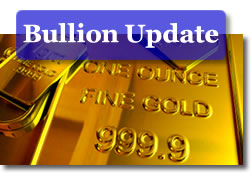 Bears Loose in Shanghai. Film at Eleven.
Bears Loose in Shanghai. Film at Eleven.
Good Afternoon,
China’s falling equity index once again set the pace for overnight market developments around the rest of the world. Apprehensions about contracting credit and the realization that bullish speculative sentiment has been way out in front of economic realities dented the Shanghai Composite by nearly 7% last night.
The overnight fall was the SCI’s largest decline in 14 months, and it once has once again tilted that market into bear territory. As the Chinese and US stock markets still offer a case of conjoined twins, the Dow did not do all that well either in early going, on this last day of August. To make matters worse, it appears that the corpulent lady has not even begun to sing as yet:
"Former Morgan Stanley Asian economist Andy Xie said that the Shanghai Composite Index (the world’s worst performer in August) may fall another 25 percent as China’s economic recovery isn’t "sustainable," Mr. Xie said the index "should be 2000 or less." "The market is in deep bubble territory," Xie, 49, who correctly predicted in April 2007 that China’s equities would tumble, said in an interview with Bloomberg Television.
"The recovery is not sustainable," Xie, who resigned as Morgan Stanley’s chief economist in Asia in 2006 and now works as an independent economist, said in the interview yesterday from Shanghai. "The government is now pulling the plug on liquidity," Xie also said. "Hopefully, it’s not too late."
The dollar recovered previously lost ground overnight, rising to 78.50 on the trade-weighted index, while crude oil took one on the chin -falling more than $3.25 or 4% in hectic trading on Monday, and nearing $69.50 per barrel. Copper lost 4.5% on the China news. Both declines were largely attributed to the slump in Chinese equities. Little wonder, as that country is in fact the planet’s second largest consumer of fossil fuel.
Gold and other precious metals prices traded significantly lower against the above-mentioned background conditions, with little in the way of bullish news to drive them on this last day of August. Spot gold opened with a $10.00 per ounce loss this Monday morning, quoted at $945.50 and traders will have very little to track in terms of US economic news until the labour market statistics hit near the end of the week.
This will likely be a stock, oil, and currency markets-driven week, once again. The Bloomberg metals analysts’ survey for the current week indicated a nearly split consensus: 11 bulls versus 9 bears and 5 neutral respondents. Whilst the range has not been undone on either end, the market’s tilt appears to be pointing towards more corrective action (see COT analysis below).
Silver started the week with a 24-cent drop, quoted at $14.56 per ounce. Platinum headed $10 lower on the open, trading at $1235.00 per ounce. Palladium fell $1 to $286.00 an ounce. The noble metals appeared unaffected by the strike action at the world’s second largest platinum producer – Impala – entering its second week. The offsetting factor -according to metals pundits- remains the slumping auto demand curve. This, despite the rather artificial spike that was likely recorded in August on the heels of the US CFC trade-in programme.
The 30-day net change in gold was last seen at the flat-to-marginally-negative percentage level despite (or, perhaps, due to) a third month of average monthly prices of well above $900 per ounce. Analysts at GoldEssential.com opine that- based on their COT figures dissection- "the conclusion is that current price levels remain based on an over-extended long positioning and thin market participation (open interest).
As such, we see any fundamental run to above the $1,000 eventually running into heavy consolidation and as such will prove little sustainable, with a high risk of resulting in significantly downwards pressure. We still feel that a correction towards $850 would result in a healthier positioning."
Well, that which we feared, and wrote about, just last Friday, in our closing comment, appears to be headed towards becoming actual headlines: "India’s gold import may have slumped by 90 per cent in August despite the advent of the festival season, as high prices prevented people from buying the precious metal, especially after drought triggered fears of dent in rural income.
Gold imports in August will remain within 10 tonnes as prices are high at over Rs 15,000 per the 10-gram level," Bombay Bullion Association Director Suresh Hundia told PTI. India imported 98 tonnes of gold in August 2008, highest in a month last year, as prices fell leading to an escalation in demand in the build-up to the previous festive season.
However, as the country is now facing a double whammy of drought in about half the region and soaring food prices, demand for gold remained subdued, as people preferred spending on basic necessities to buying jewellery, according to Hundia.
Poor rains this year have raised fears of a slump in farm output affecting rural income, as over 60 per cent of India’s population still depends on agriculture for livelihood. More importantly, the import of gold this festival season (September-December) may not match the last year level of 146 tonnes if prices remain firm, Hundia said." – The above, according to India’s Economictimes.
Other equity markets also followed lower in sympathy with the one in Shanghai, falling by various amounts, from Tokyo to Frankfurt, albeit some analysts at least partially peg Japan’s market losses to the DPJ’s election victory. Over in Euro Zone, inflation remained looking like disinflation, for the third month in a row. Prices fell by 0.2% in August, even as the region appears to be climbing out of recession.
As for the US, a Bloomberg survey of economists finds that they see the Fed having to cope with an overshoot of its 2% inflation target in coming years. Hardly the Harare-on-the-Hudson that the hyperinflationary hyperactive crowd is warning about, but 3% per annum is still 50% above target, and the highest inflation level since 1992. Still, not everyone is convinced that we will necessarily face such inflationary rough seas.

According to Bloomberg,
"New York Federal Reserve Bank President William Dudley said the Fed has the tools to prevent inflation from accelerating and doesn’t need to begin trimming its balance sheet.
The central bank, seeking to stimulate the economy and unclog credit markets, has created emergency lending programs and doubled the size of its assets during the past year to more than $2 trillion. Dudley, differing from comments by two Fed district bank presidents last week, said today it’s too early to consider curtailing the aid.
Richmond Fed President Jeffrey Lacker and St. Louis Fed President James Bullard said at separate events on Aug. 27 that the central bank may not need to buy the full $1.25 trillion in mortgage-backed securities that has been authorized by year-end.
The Fed’s lending programs have led to a large expansion in the reserves banks keep at the central bank. Dudley said those reserves can be drained from the system before leading to an increase in lending and worsening inflation.
"My view is we have tools to manage our balance sheet so we’re not going to have an inflation outcome, a bad inflation outcome," Dudley said. "With the Fed’s ability to pay interest on excess reserves, the banks just take the excess reserves to the Fed, get paid interest. They don’t lend them out. So you don’t get that cycle of the excess reserves leading to a credit boom and an overheated economy."
Many of the Fed’s credit programs are designed to wind down as private lending recovers, Dudley said. "So our balance sheet was virtually unchanged from where it was at the end of the year, even though we’ve been buying hundreds of billions of dollars of securities," Dudley said.
There is no sign the Fed’s actions spurred inflation. Consumer prices were unchanged in July, and compared with a year earlier, consumer prices were down 2.1 percent, the biggest 12- month decrease since 1950. Dudley said the Fed is "far along" in its planning for an exit from the extraordinary policy actions of the past year.
Along with paying interest on excess reserves, the central bank may also do reverse repurchase agreements, lending securities into the market in exchange for cash, and create special interest-bearing accounts at the Fed for banks to deposit their excess reserves.
The New York Fed president said he wouldn’t give in to any political pressure to keep interest rates low for too long.
"All I know is that I am committed to taking away the punch bowl at the right time. I have no desire whatsoever to see inflation get out of control." [Ben] Bernanke "feels exactly the same way," he said, "and 99.9 percent of the time we’re on the same page. So I have every confidence he’s going to do the right thing, and that we’re both going to do the right thing." The timing of any change in policy will be tricky, Dudley said.
"We won’t know with certainty," he said. "What we’ll see is an economy that’s doing better, that the unemployment rate is declining. We’re obviously going to have to be paying very close attention to what’s going on in inflation, because it’s very possible that inflation is going to continue to decline for a while. There’s quite a bit of slack in the economy right now."
Evidently, the struggle of the moment is to keep afloat and not sink into the opposite direction despite several recent dips under the inflation/deflation waterline. There remains that danger, and then some, according to some sources.
For example, uber-pessimistic Elliott Wave Financial Forecaster sees that the "debate over ‘universal health care’ is the perfect place for the optimistic psychology of a Grand Supercycle degree peak to have its last stand, as stocks reach back toward Dow 10,000 one last time … such reforms [are] obvious manifestations of an extreme attitude about entitlements to comfort and support that may not have existed in history except perhaps in the late Roman Empire."

Jon Nadler
Senior Analyst
Kitco Metals Inc.
North America
Websites: www.kitco.com and www.kitco.cn
Blog: http://www.kitco.com/ind/index.html#nadler
Check out CoinNews market resources at Live Bullion Spots, the Silver Calculator, U.S. Mint Collector Bullion Coin Price Guide. Calculate inflation and easily find how the buying power of the dollar has changed from 1913-2009.










